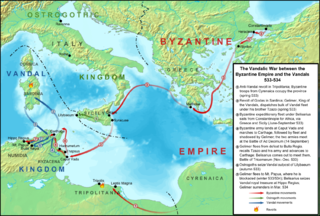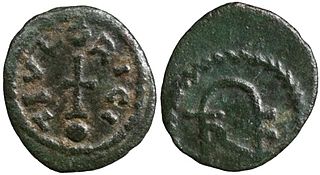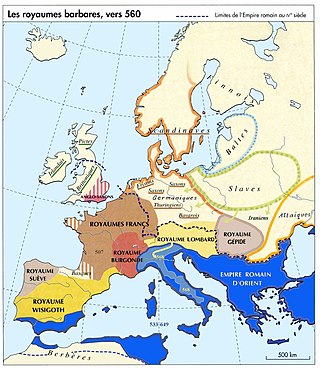The 530s decade ran from January 1, 530, to December 31, 539.

Year 533 (DXXXIII) was a common year starting on Saturday of the Julian calendar. At the time, it was known as the Year of the Consulship of Iustinianus without colleague. The denomination 533 for this year has been used since the early medieval period, when the Anno Domini calendar era became the prevalent method in Europe for naming years.

Theuderic I was the Merovingian king of Metz, Rheims, or Austrasia—as it is variously called—from 511 to 534.

Theudebert I was the Merovingian king of Austrasia from 533 to his death in 548. He was the son of Theuderic I and the father of Theudebald.

Chlothar II, sometime called "the Young", was king of the Franks, ruling Neustria (584–629), Burgundy (613–629) and Austrasia (613–623).

Chlothar I, sometime called "the Old", also anglicised as Clotaire, was a king of the Franks of the Merovingian dynasty and one of the four sons of Clovis I.

The Kingdom of the Franks, also known as the Frankish Kingdom, the Frankish Empire or Francia, was the largest post-Roman barbarian kingdom in Western Europe. It was ruled by the Frankish Merovingian and Carolingian dynasties during the Early Middle Ages. Francia was among the last surviving Germanic kingdoms from the Migration Period era.

Sigismund was King of the Burgundians from 516 until his death. He was the son of king Gundobad and Caretene. He succeeded his father in 516. Sigismund and his brother Godomar were defeated in battle by Clovis's sons, and Godomar fled. Sigismund was captured by Chlodomer, King of Orléans, where he was kept as a prisoner. Later he, his wife and his children were executed. Godomar then rallied the Burgundian army and won back his kingdom.
Hermanfrid was the last independent king of the Thuringii in present-day Germany. He was one of three sons of King Bisinus and the Lombard Menia. His siblings were Baderic; Raicunda, married to the Lombard king Wacho; and Bertachar.
Amalafrid was the son of the last Thuringian king Hermanafrid and his wife Amalaberga, daughter of Amalafrida and niece of the Ostrogothic king Theodoric the Great.

Theuderic III was King of the Franks. He ruled Neustria and Burgundy on two occasions, as well as Austrasia from 679 to his death in 691.

Radegund was a Thuringian princess and Frankish queen, who founded the Abbey of the Holy Cross at Poitiers. She is the patron saint of several churches in France and England and of Jesus College, Cambridge.

Aregund, Aregunda, Arnegund, Aregonda, or Arnegonda was a Frankish queen. She is the earliest known queen of Francia.
Amalafrida was queen of the Vandals by marriage to Thrasamund. She was the daughter of Theodemir, king of the Ostrogoths, and his wife Erelieva. She was the sister of Theodoric the Great, and mother of Theodahad, both of whom also were kings of the Ostrogoths.
Baderic, Baderich, Balderich or Boderic, son of Bisinus and Menia, was a co-king of the Thuringii. He and his brothers Hermanfrid and Berthar succeeded their father Bisinus. After Hermanfrid defeated Berthar in battle, he invited King Theuderic I of Metz to help him defeat Baderic in return for half of the kingdom. Theuderic I agreed and Baderic was defeated and killed in 529. Hermanfrid became the sole king.
Bertachar was a king of Thuringia from about 510 until about 525, co-ruling with his brothers Hermanfrid and Baderic.
Godomar II, son of king Gundobad, was king of Burgundy. He ruled Burgundy after the death of Sigismund, his elder brother, in 524 until 534.

Alduin was king of the Lombards from 547 to 560.
Rodelinda (6th-century), was a Lombard queen by marriage to king Audoin, and mother of king Alboin.
The Duchy of Thuringia was an eastern frontier march of the Merovingian kingdom of Austrasia, established about 631 by King Dagobert I after his troops had been defeated by the forces of the Slavic confederation of Samo at the Battle of Wogastisburg. It was recreated in the Carolingian Empire and its dukes were appointed by the king until it was absorbed by the Saxon dukes in 908. From about 1111/12 the territory was ruled by the Landgraves of Thuringia as Princes of the Holy Roman Empire. When Frederick IV, the last independent ruler of Thuringia died in 1440, the territory passed to his nephew, the saxon elector Frederick II.










